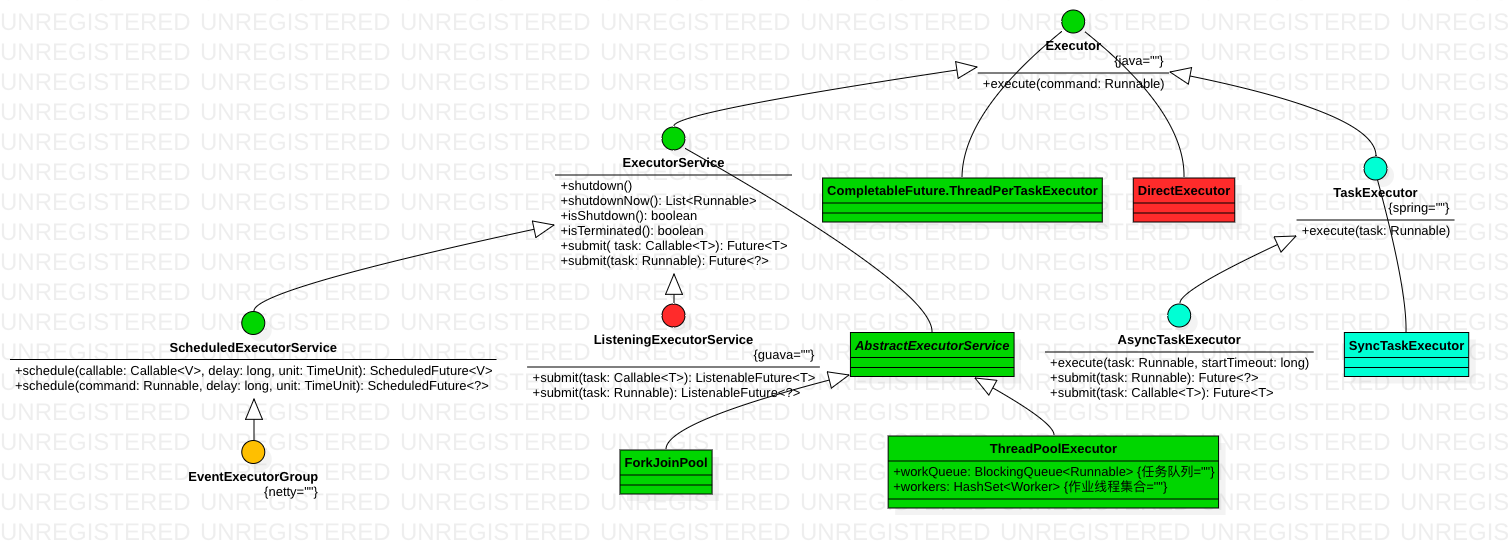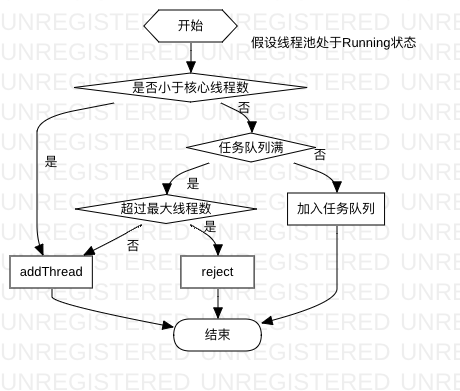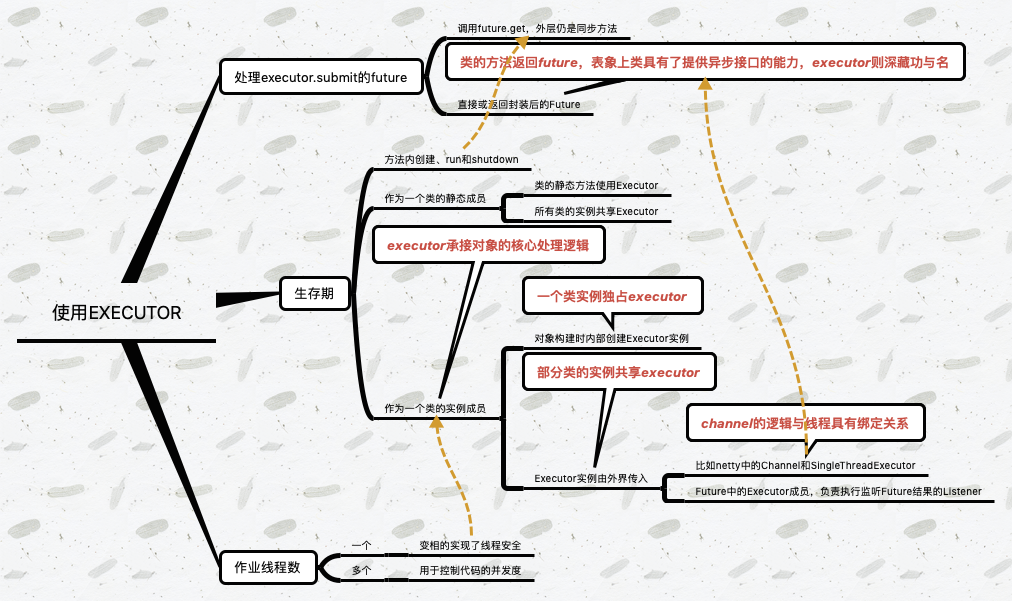简介
- 简介
- 百花齐放的Executor
- 线程复用——ThreadPoolExecutor
- 对Executor 的扩展
- Executor的使用
- 百花齐放的Future
- 对Future 的扩展
- 保护调用者/驱动线程
建议先对不同层面的异步 有一点感觉
从本文内容可以看到,任何业务逻辑都可以用全异步代码来完成,其本质是业务逻辑分拆在多个线程中,Executor 和Future 封装了业务逻辑的分拆和中间结果的组合。PS:有种分布式任务处理的感觉。
百花齐放的Executor
Runnable + Thread 实现了 logic 和 runner 的分离,runner 又进一步扩展为 executor

Executor provides a way of decoupling task submission from the mechanics of how each task will be run, including details of thread use, scheduling, etc. Executor 是一个如此成功的抽象,就像linux的File 接口一样。 任务的提交与执行相分离。 PS:有点类似于Spring IOC,Bean的创建与使用相分离。
Executor 框架为并发编程提供了一个完善的架构体系,不仅包括了线程池的管理,还提供了线程工厂、队列(类似于操作系统中的task_struct 数组)以及拒绝策略等,将线程的调度和管理设置在了用户态。
谁来处理task
-
任务被caller’s thread 执行,此时是同步操作。the Executor interface does not strictly require that execution be asynchronous. 比如上图的DirectExecutor
class DirectExecutor implements Executor { public void execute(Runnable r) { r.run(); } } -
ThreadPerTask,PS: 有点类似Kubernetes 中的ip-per-pod
class ThreadPerTaskExecutor implements Executor { public void execute(Runnable r) { new Thread(r).start(); } } -
最常用的还是 ThreadPoolExecutor 这种,executes each submitted task using one of possibly several pooled threads,线程复用,这也是logic 和 runner 分离的好处
同步方法有参数和返回值,异步方法也有参数和返回值,只是异步方法的返回值 统一为Future 抽象。我们可以直接对同步方法的返回值进行处理,而java 也在不断地对Future进行扩展以对异步结果进行处理。
线程复用——ThreadPoolExecutor
戏(细)说 Executor 框架线程池任务执行全过程(上)
提交任务
ThreadPoolExecutor.execute 这个方法看着比较简单,但是线程池什么时候创建新的作业线程来处理任务,什么时候只接收任务不创建作业线程,另外什么时候拒绝任务。线程池的接收任务、维护工作线程的策略都要在其中体现。

作业线程
与ThreadPerTaskExecutor 中的线程不同,线程复用之后,ThreadPoolExecutor 中的线程必须改造为拥有task处理逻辑的作业线程,还必须负责作业线程的创建于销毁。
有一个形象的比喻:经理给组长提任务,并不管组长是自己做还是分派给下面的小伙伴。经理等着组长report 即可,从小伙伴的视角看,每天的“日常”就是不停的从组长那里领取task,组长视情况给任务排期,实在忙不过来便增加人手。
作业线程逻辑
worker线程在受限的条件下创建,其工作内容便是 不停的从workQueue 中取出task 并执行。
private final class Worker implements Runnable{
public void run() {
try {
Runnable task = firstTask;
// 循环从线程池的任务队列获取任务
while (task != null || (task = getTask()!= null) {
// 执行任务
runTask(task);
task = null;
}
} finally {
workerDone(this);
}
}
private void runTask(Runnable task) {
task.run();
}
}
作业线程的管理
ThreadPoolExecutor 作业线程 由一个HashSet 成员专门持有, 管理/crud大都由调用方线程触发
- caller thread 提交任务,在特定场景下(核心线程数、最大线程数、任务队列长度),由addThread 创建新线程
- caller thread 线程调用shutdown,作业线程在 没有任务或shutdown状态下自动结束
创建新的作业线程逻辑
private Thread addThread(Runnable firstTask) {
// 为当前接收到的任务 firstTask 创建 Worker
Worker w = new Worker(firstTask);
Thread t = threadFactory.newThread(w);
w.thread = t;
// 将 Worker 添加到作业集合 HashSet<Worker> workers 中,并启动作业
workers.add(w);
t.start();
return t;
}
对Executor 的扩展
对Executor 的扩展 主要体现在几个方面
- 规范 作业线程的管理,比如ExecutorService
- 提供 更丰富的 异步处理返回值 ,比如guava 的ListeningExecutorService
- 优化特定场景,比如netty的SingleThreadEventExecutor,只有一个作业线程
- 针对特定业务场景,更改作业线程的处理逻辑。比如netty的EventLoopGroup,其作业线程逻辑为 io + task ,并可以根据ioRatio 调整io 与task的cpu 占比。
在 ExecutorService 中,正如其名字暗示的一样,定义了一个服务,定义了完整的线程池的行为,可以接受提交任务、执行任务、关闭服务。抽象类 AbstractExecutorService 类实现了 ExecutorService 接口,也实现了接口定义的默认行为。
Using as a generic library 将netty的并发编程库与guava 与jdk8 做了对比,Because Netty tries to minimize its set of dependencies, some of its utility classes are similar to those in other popular libraries, such as Guava.
在上图中,netty EventExecutorGroup 的方法返回的是netty 自己实现的io.netty.util.concurrent.Future extends java.util.concurrent.Future,guava 则直接一点,ListeningExecutorService 直接返回自己定义的com.google.common.util.concurrent.ListenableFuture extends java.util.concurrent.Future
EventExecutorGroup 使用实例(不一定非得netty里才能用)
EventExecutorGroup group = new DefaultEventExecutorGroup(4); // 4 threads
Future<?> f = group.submit(new Runnable() { ... });
f.addListener(new FutureListener<?> {
public void operationComplete(Future<?> f) {
..
}
});
...
Executor的使用

百花齐放的Future
Chaining async calls using Java Futures

- A Future represents the result of an asynchronous computation.
- Future 模式相当于一个占位符,代表一个操作的未来的结果
- A Future (also called promise, task or deferred depending on the programming language) is a proxy to an asynchronous computation
- This approach of making Future a type means that an asynchronous computation is a first class object, which can be passed to other functions and received as a result。 如果异步方法只能通过回调来处理异步结果,则异步方法就不能作为另一个方法的参数了。
- Future also makes chains of transformations easily doable via functions like map, which allow you to transform the result into a result of another type while using a strongly typed and unit testable function. 与Future 神似的是Optional,它们都可以采用Stream 类似的方法链
谁来处理异步操作的结果
异步和回调是孪生兄弟,毕竟不管同步还是异步,都要对拿到的结果进行处理。对结果的处理,可以直接写在异步方法的回调中,也可以挂在异步方法返回的future中。异步本身分为调用线程和执行线程,对异步结果的后续处理也有几种情况
1. 执行线程处理
2. 额外传入一个executor线程(池)处理,此时对异步结果的处理 本身又可以一个异步操作
此外,我们可以按功能对线程池进行划分,比如rpc框架中的快慢线程池、IO框架中的IO线程池和CPU密集型线程池。
One issue with complex workflows is that you might have a mixture of CPU and I/O intensive steps. The most common way to solve this problem is to use two thread pools, one with a large number of threads for I/O and another one with one thread per physical core for CPU intensive tasks. This means that in addition to specifying the order of the steps, we also have to specify where should each function be executed. Future also helps us with this problem, because the supplyAsync method also allows fine grained control of where each function should be executed.
FutureTask
我们来看一个Futrue的简单使用
ExecutorService executor = Executors.newFixedThreadPool();
Future<Integer> future = executor.submit(new MyJob()));
跟踪submit方法所属的类,Executors.newFixedThreadPool() ==> ThreadPoolExecutor ==> AbstractExecutorService
public <T> Future<T> submit(Callable<T> task) {
if (task == null) throw new NullPointerException();
RunnableFuture<T> ftask = newTaskFor(task);
execute(ftask);
return ftask;
}
protected <T> RunnableFuture<T> newTaskFor(Runnable runnable, T value) {
return new FutureTask<T>(runnable, value);
}
返回的future是一个FutureTask,FutureTask是interface RunnableFuture<V> extends Runnable, Future<V>的实现类。
对Future 的扩展
不管同步异步,都要拿到数据的结果,并且对拿到的结果进行后续处理。区别只是,同步代码是按照时间顺序书写的,更符合人类直觉,而异步代码则要转换下思维,Future future = timeConsumingOperation() 之后立马future.get() 就没什么意思了, 所以异步代码的“文风”(学名:异步流程控制模式)有几种
- 串行(series),后一个调用参数依赖前一个调用的结果。
- 并行(parallel),连续发起多个异步操作,然后对异步结果进行组合
- 瀑布(waterfall)等,后一个调用是否执行 + 调用参数 依赖前一个调用的结果
解决回调地狱——promise模式
Netty 和 Guava 的扩展都提供了 addListener 这样的接口,用于处理 Callback 调用,但future的Callback容易出现回调地狱的问题,由此衍生出了 Promise 模式来解决这个问题。
jdk1.8 也提供了相关的方案:CompletableFuture,A Future that may be explicitly completed (setting its value and status), and may be used as a CompletionStage, supporting dependent functions and actions that trigger upon its completion.
[concurrency-interest] CompletableFuture CompletableFuture 曾经被讨论过以下命名:SettableFuture, FutureValue, Promise, and probably others.
基于异步接口组织业务逻辑——编排/Futures
the biggest advantage of using Futures is composability. You might imagine that dealing with transformations which are themselves asynchronous means having to somehow extract your result from a mess that looks like Future<Future<…<Future<T>>…>>. The existence of methods like thenCompose means that any sequence of asynchronous operations will be handled like one asynchronous operation in the rest of your program and this what makes reasoning about and working with these operations much easier. 将多个异步操作组合为一个异步操作
CompletionFutre
我们看jdk1.8 CompletionFutre,可以看到:各种thenXX,即便对同步调用的返回值进行各种处理,也不过如此了。将异步代码写的如何更像 同步代码 一点,是异步抽象/封装一个发展方向。
void business(){
Value value1 = timeConsumingOperation1();
Object result1 = function1(value1);
Object result2 = function2(value1);
Value value2 = timeConsumingOperation2();
Object result3 = function3(value1,value2);
...
}
void business(){
CompletionFutre future1 = timeConsumingOperationAsync1();
CompletionFutre future2 = timeConsumingOperationAsync2();
future.thenApply(function1).thenApply(function2).thenCombine(future2,function3);
...
}
guava ListenableFuture和AbstractFuture
ListenableFuture的简单使用
ListeningExecutorService executorService = MoreExecutors.listeningDecorator(Executors.newCachedThreadPool());
final ListenableFuture<Integer> listenableFuture = executorService.submit(new MyJob<Integer>());
// 添加监听事件
Futures.addCallback(listenableFuture, new FutureCallback() {
public void onSuccess(Integer result) {
}
public void onFailure(Throwable thrown) {
}
});
跟踪submit方法所属的类,ListeningExecutorService ==> AbstractListeningExecutorService ==> AbstractExecutorService
public abstract class AbstractListeningExecutorService extends AbstractExecutorService{
protected final <T> ListenableFutureTask<T> newTaskFor(Runnable runnable, T value){
return ListenableFutureTask.create(runnable, value);
}
public <T> ListenableFuture<T> submit(Callable<T> task) {
return (ListenableFuture)super.submit(task);
}
}
public abstract class AbstractExecutorService implements ExecutorService{
public <T> Future<T> submit(Callable<T> task) {
if (task == null) throw new NullPointerException();
RunnableFuture<T> ftask = newTaskFor(task);
execute(ftask);
return ftask;
}
}
实际执行的submit方法和上节的submit方法一样一样的,但在submit方法中,上节执行的是AbstractExecutorService.newTaskFor返回FutureTask,此处执行的是AbstractListeningExecutorService.newTaskFor返回ListenableFutureTask,其实际也是个java.util.concurrent.FutureTask。所以一个ListenableFuture具有cancel的能力就不奇怪了。看来本质上,ListenableFutureTask取消任务的方式还是和FutureTask一样。
ListenableFuture所具备的addListener方法则是任务挂在一个地方,当run方法执行完毕后,执行这些任务。(不同的guava版本实现代码有很大不同)
保护调用者/驱动线程
代码交给另一个线程执行,还有一个好处,就是保护调用者线程。
在一个项目中,不同的线程的重要性是不同的,比如tomcat 线程池中的线程、mq 消费者线程、netty 的事件驱动线程等,它们是驱动 代码执行的源动力。假设tomcat 线程池一共10个线程,当中有一个任务处理较慢,一个线程被占用较长的时间,会严重限制tomcat的吞吐量。
但总有各种耗时的任务,此时,一个重要方法是将 任务交给另一个 线程执行。调用线程 持有 future 对象,可以主动选择 等、不等或者等多长时间。这一点 可以在hystrix 看到。
